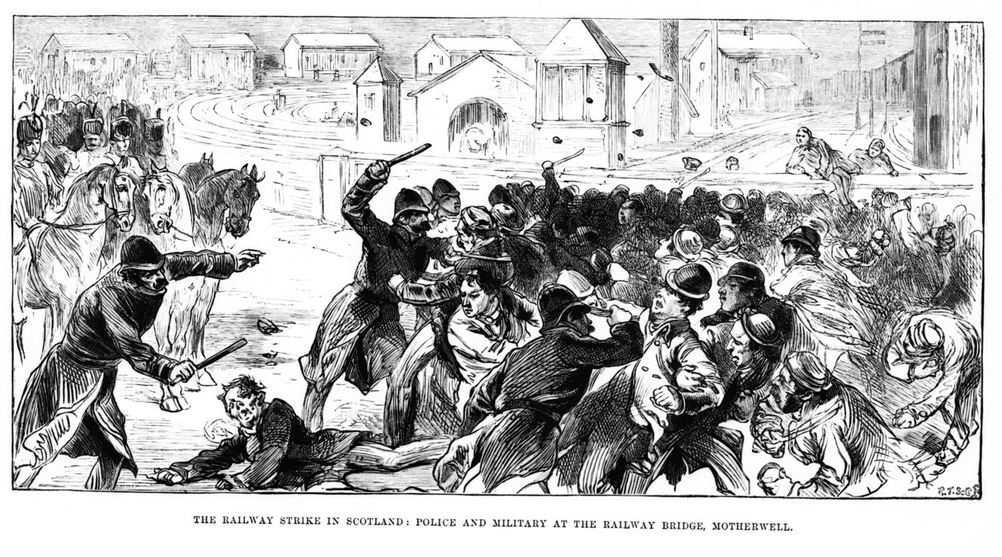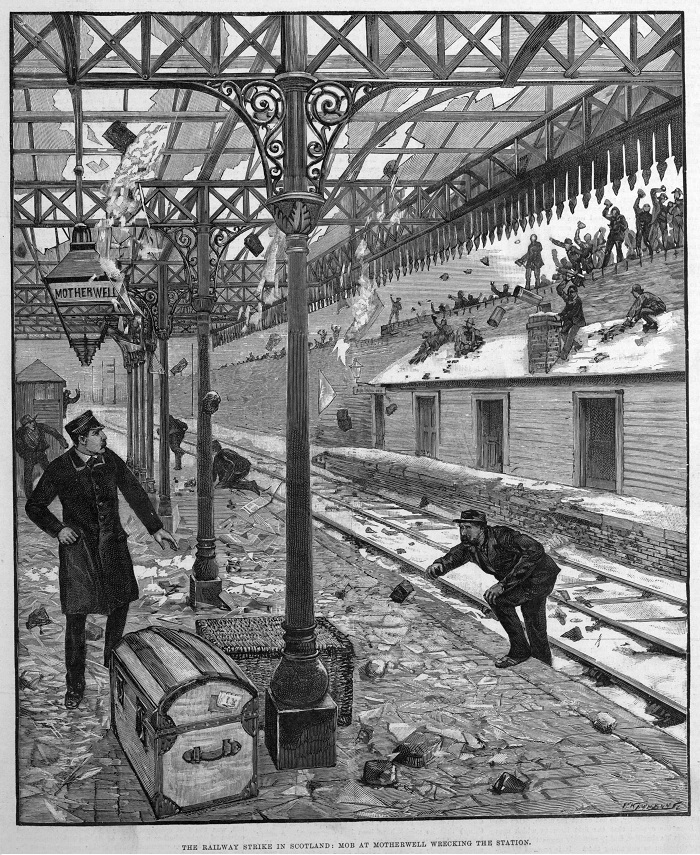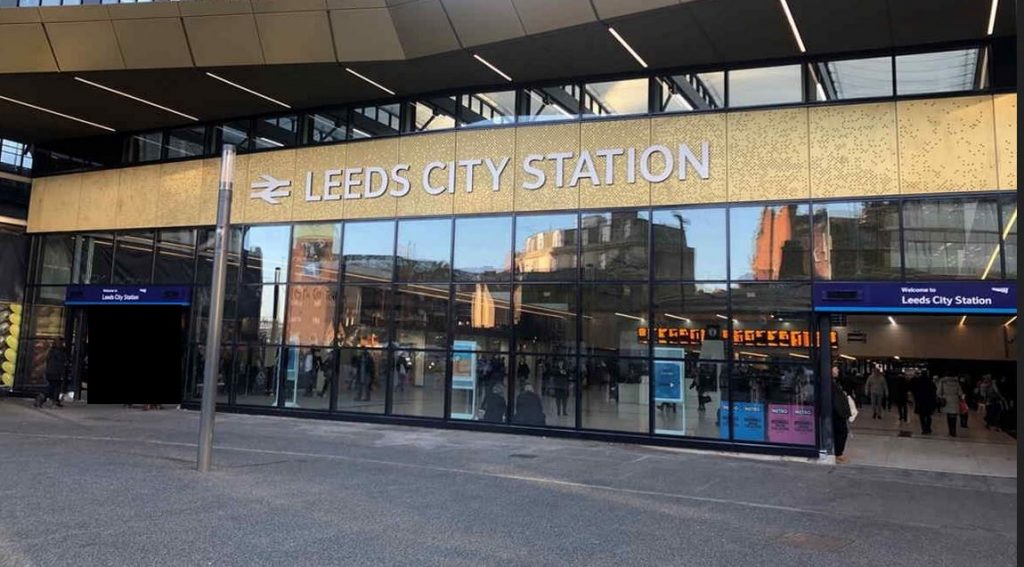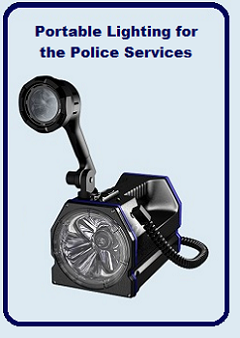Uncategorized
Outside of London, Glasgow has one of the most intensive suburban railway networks in the UK, and just like their modern counterparts, rail workers in Glasgow in 1890 were fed up with working conditions and miniscule pay increases.

In those days, the majority of rail employees worked at one of three rival firms: the Caledonian, North British and Glasgow & South Western railway companies.
These companies were making huge profits as the number of Scots travelling by rail soared. At the same time working hours for rail staff was becoming intolerable. The average engine driver, signalman and shunter was working shifts of 14 to 15 hours a day. Some workers, it was found, were on shift for 20-30 hours at a stretch. In December 1890, Glasgow’s rail workers came together through their unions in what would become the largest rail strike ever witnessed in Scotland and demanded a 10-hour day.
Knowing their hand would be strengthened with Christmas fast approaching, the city’s rail workers realised it was now or never.
Picket lines were set up suddenly and without warning , on the morning of December 22, 1890. Workers in Edinburgh, Dundee and elsewhere joined the cause, sparking chaos across the country. On that first day, more than 4,500 workers abandoned their posts, with a further 5,000 joining them over the following four days. Passenger services immediately became late and irregular.
Trade was affected too, with goods traffic almost non-existent and factories across the Central Belt ceasing production due to a shortage of coal.
The tense situation reached a head at Motherwell on January 5, when the Caledonian Railway Company terminated the contracts of striking workers who had only recently taken up employment with the firm. The decision meant many young families being forcibly evicted from their homes, which had been supplied by the railway company.
Caledonian bosses said it was their legal entitlement to sack the workers – but this was an irrelevance to the men on strike and their supporters in North Lanarkshire.

Incensed by the evictions, a hostile crowd of around 20,000 assembled to make their feelings clear. Riotous scenes erupted with protesters hurling rocks and causing damage to signal boxes on the railway lines. Mounted police and military were called upon to disperse the crowd, leaving a number of people injured.
After six long weeks the rail companies agreed to improve working hours for their staff and the strike ended.
The Caledonian Railway Company also dropped all actions for damages at Motherwell Station and allowed most of the men who had been fired to return to their company homes.
We can only hope that the current rail strike reaches a rapid and acceptable conclusion for all involved – not least of all, the commuter!
The best flashlights for emergency use are ones with a long battery life and a powerful beam and White Knight offer two solutions for emergency hand-held lighting.
WK-5 Hand Lamp
- Designed for long and short distance work
- A powerful torch that is moulded from high impact plastic to withstand the toughest conditions – durability that will last for years
- Used by police, fire and ambulance services throughout the world
- A comprehensive choice of models 30watt, 20watt, 10watt and 6watt halogen output
- Provides 75 minutes to 7 hours continuous illumination
- Available with Ni-MH 6V 7Ah battery packs
- Approved for use by the MOD and NATO forces

Halo Plus2™ HP-11 Personal Torch
Where guaranteed performance in non-hazardous situations is the criterion, the Halo Plus2™ provides a reliable way forward for the security services and transport industries.
- Delivers a constant 10,000 candlepower
- Up to 5 hours continuous light High / low beam option switch Interchangeable battery cassette
- Integral belt clip
- NATO Stock No. 6230 998628598

White Knight have been producing rechargeable handlamps since 1976, and are constantly researching and developing their products.
 Those of us who regularly use trains will no doubt be relieved to hear that transport secretary, Grant Shapps is to review repetitive and unnecessary announcements on trains in an attempt to make train travel more attractive to commuters.
Those of us who regularly use trains will no doubt be relieved to hear that transport secretary, Grant Shapps is to review repetitive and unnecessary announcements on trains in an attempt to make train travel more attractive to commuters.
Mr. Shapps said ‘Train passengers are all too often plagued by an endless torrent of repeated and unnecessary announcements.’. He went on to say that he is ‘calling for a bonfire of the banalities to bring down the number of announcements passengers are forced to sit through and make their journey that little bit more peaceful.’
This should bring an end to the repetition of less-than vital-messaging like shoes on seats, noisy headphones, and litter in bins,” but the Department for Transport (DfT) said key safety messages would remain. So sadly, no reprieve from British Transport Police’s “most annoying slogan of the century”, “See it. Say it. Sorted”.
The DfT said it would be working closely with the Rail Delivery Group and passenger groups such as Transport Focus, as well as train operators, to identify how the “vast number” of announcements could be cut or reduced.
Commuters can now look forward to not being reminded when the food court is closing, having their tickets ready, and the most annoying of all, constant reminders that you are in a quiet carriage (where the only noise is coming from the tannoy system).
Although the government does not have the power to stop this “bonfire of banalities”, they are hoping that the rail industry will limit announcements that are not critical and prioritise a calmer environment for passengers.
Mick Lynch, general secretary of the Rail, Maritime, and Transport union (RMT), said the policy was “clearly nothing but a PR stunt by this collapsing Government”.
A number of these announcements are imposed on the train companies by the DfT, and many of them are essential for blind passengers.
The move has been welcomed by Transport Focus and the Rail Delivery Group.
We await further announcements…

Wendy Morton, the rail minister, has praised the new £161m upgrade to Leeds station which will transform rail journeys across Yorkshire.
The Minister met with former apprentices and Network Rail staff who have helped deliver the upgrades to the Trans Pennine Route.
New tracks and longer platforms are included in the £161m upgrade which will provide passengers with more seats, services, and more punctual journeys.
The Leeds station upgrade forms part of the Government’s £96bn Integrated Rail Plan (IRP) aimed at transforming rail connections in the North and Midlands.
Speaking on the upgrade Rail Minister Wendy Morton said: “Leeds station is a major hub right at the heart of the North. It is not only a gateway to one of the UK’s most vibrant and lively cities but a vital transport link.”
She added that this would enable people from all over the country to travel for work, pleasure and connect with friends and family. These upgrades are a huge milestone and will go a long way to delivering a modern, fully connected transport hub fit for the future. Passengers should also see improvements to journey times much sooner than under previous plans with the IRP.
Councillor James Lewis said that the upgrades at Leeds station were an important milestone in the continued ambitions to modernise Leeds rail connections.
The upgrades are a first step towards beginning to address the capacity issues at Leeds station.
“We will work with the government to secure a robust strategy for ongoing enhancements to improve connectivity for Leeds that will benefit Yorkshire, the North and the UK.”
Upgrades to Leeds station were completed by engineers over the New Year break.
 A Polish climber who wanted to be airlifted off the top of Mont Blanc because he was “scared” had his request flatly turned down. He was also refused permission to hire a private helicopter to airlift him, and was forced to make his down the same way he came up – by foot.
A Polish climber who wanted to be airlifted off the top of Mont Blanc because he was “scared” had his request flatly turned down. He was also refused permission to hire a private helicopter to airlift him, and was forced to make his down the same way he came up – by foot.
This is due to the local Mountain Rescue Service and the mayor of Saint-Gervais, the closest village becoming annoyed with climbers who are ill-prepared. The story is entertaining and one’s sympathy is certainly not with the climber.
However the story does highlight how Rescue Services are constantly putting themselves at risk to rescue people who are, at best naïve, and at worst downright irresponsible!
The article states that there between 350 and 400 climbing parties attempting to climb Mont Blanc every day in summer.
As the article points out mountains are not like amusement parks, and people should ensure that are fully competent, experienced and equipped before undertaking any adventure that has the potential to put someone else’s life at risk
Mountain Rescue Services throughout the world provide an invaluable service and the brave men and women who volunteer for these services are all heroes!
Read the article in the Telegraph – and make sure you’re not the one making the next headline.


